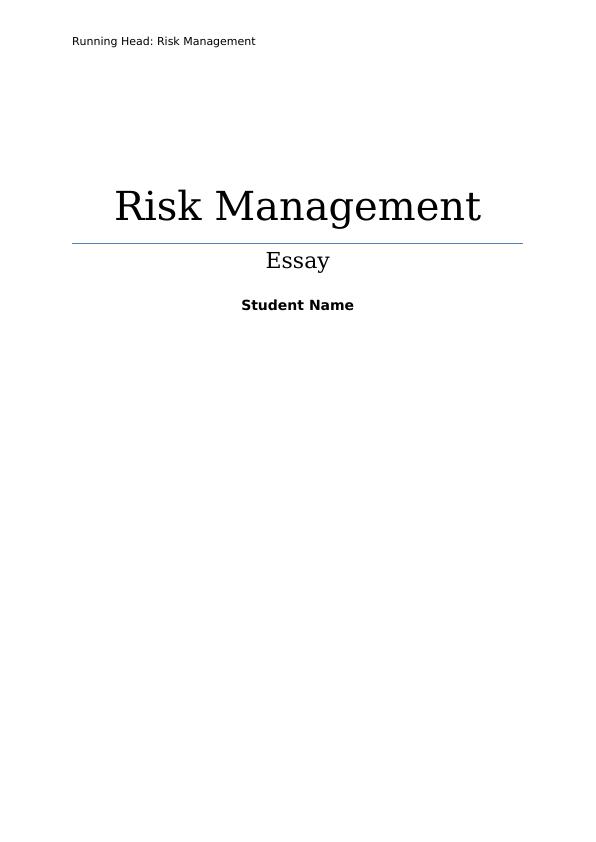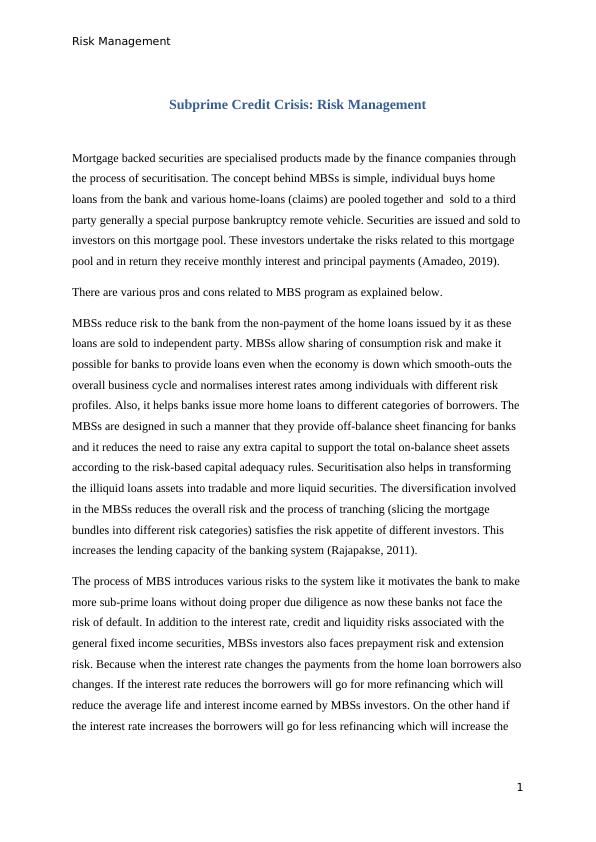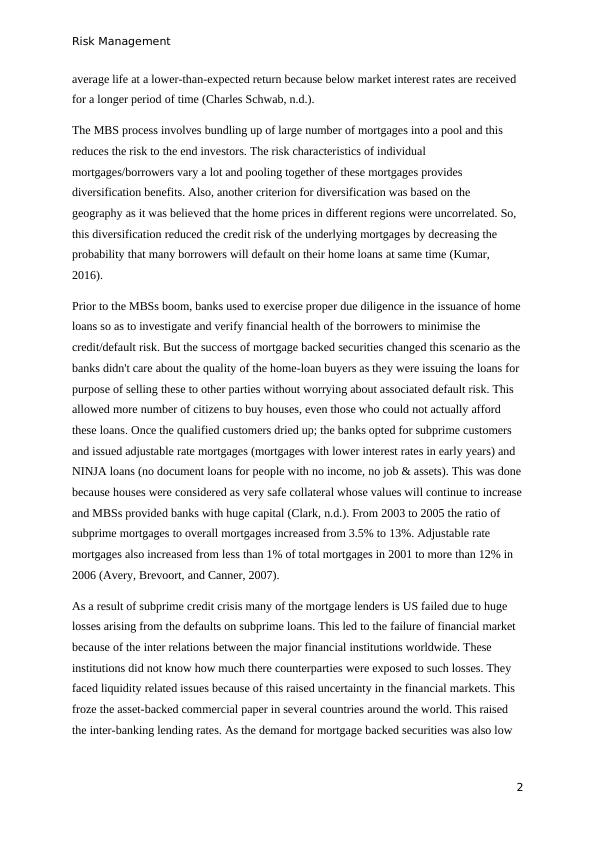Subprime Credit Crisis: Risk Management
Added on 2023-01-05
8 Pages2360 Words22 Views
Running Head: Risk Management
Risk Management
Essay
Student Name
Risk Management
Essay
Student Name

Risk Management
Subprime Credit Crisis: Risk Management
Mortgage backed securities are specialised products made by the finance companies through
the process of securitisation. The concept behind MBSs is simple, individual buys home
loans from the bank and various home-loans (claims) are pooled together and sold to a third
party generally a special purpose bankruptcy remote vehicle. Securities are issued and sold to
investors on this mortgage pool. These investors undertake the risks related to this mortgage
pool and in return they receive monthly interest and principal payments (Amadeo, 2019).
There are various pros and cons related to MBS program as explained below.
MBSs reduce risk to the bank from the non-payment of the home loans issued by it as these
loans are sold to independent party. MBSs allow sharing of consumption risk and make it
possible for banks to provide loans even when the economy is down which smooth-outs the
overall business cycle and normalises interest rates among individuals with different risk
profiles. Also, it helps banks issue more home loans to different categories of borrowers. The
MBSs are designed in such a manner that they provide off-balance sheet financing for banks
and it reduces the need to raise any extra capital to support the total on-balance sheet assets
according to the risk-based capital adequacy rules. Securitisation also helps in transforming
the illiquid loans assets into tradable and more liquid securities. The diversification involved
in the MBSs reduces the overall risk and the process of tranching (slicing the mortgage
bundles into different risk categories) satisfies the risk appetite of different investors. This
increases the lending capacity of the banking system (Rajapakse, 2011).
The process of MBS introduces various risks to the system like it motivates the bank to make
more sub-prime loans without doing proper due diligence as now these banks not face the
risk of default. In addition to the interest rate, credit and liquidity risks associated with the
general fixed income securities, MBSs investors also faces prepayment risk and extension
risk. Because when the interest rate changes the payments from the home loan borrowers also
changes. If the interest rate reduces the borrowers will go for more refinancing which will
reduce the average life and interest income earned by MBSs investors. On the other hand if
the interest rate increases the borrowers will go for less refinancing which will increase the
1
Subprime Credit Crisis: Risk Management
Mortgage backed securities are specialised products made by the finance companies through
the process of securitisation. The concept behind MBSs is simple, individual buys home
loans from the bank and various home-loans (claims) are pooled together and sold to a third
party generally a special purpose bankruptcy remote vehicle. Securities are issued and sold to
investors on this mortgage pool. These investors undertake the risks related to this mortgage
pool and in return they receive monthly interest and principal payments (Amadeo, 2019).
There are various pros and cons related to MBS program as explained below.
MBSs reduce risk to the bank from the non-payment of the home loans issued by it as these
loans are sold to independent party. MBSs allow sharing of consumption risk and make it
possible for banks to provide loans even when the economy is down which smooth-outs the
overall business cycle and normalises interest rates among individuals with different risk
profiles. Also, it helps banks issue more home loans to different categories of borrowers. The
MBSs are designed in such a manner that they provide off-balance sheet financing for banks
and it reduces the need to raise any extra capital to support the total on-balance sheet assets
according to the risk-based capital adequacy rules. Securitisation also helps in transforming
the illiquid loans assets into tradable and more liquid securities. The diversification involved
in the MBSs reduces the overall risk and the process of tranching (slicing the mortgage
bundles into different risk categories) satisfies the risk appetite of different investors. This
increases the lending capacity of the banking system (Rajapakse, 2011).
The process of MBS introduces various risks to the system like it motivates the bank to make
more sub-prime loans without doing proper due diligence as now these banks not face the
risk of default. In addition to the interest rate, credit and liquidity risks associated with the
general fixed income securities, MBSs investors also faces prepayment risk and extension
risk. Because when the interest rate changes the payments from the home loan borrowers also
changes. If the interest rate reduces the borrowers will go for more refinancing which will
reduce the average life and interest income earned by MBSs investors. On the other hand if
the interest rate increases the borrowers will go for less refinancing which will increase the
1

Risk Management
average life at a lower-than-expected return because below market interest rates are received
for a longer period of time (Charles Schwab, n.d.).
The MBS process involves bundling up of large number of mortgages into a pool and this
reduces the risk to the end investors. The risk characteristics of individual
mortgages/borrowers vary a lot and pooling together of these mortgages provides
diversification benefits. Also, another criterion for diversification was based on the
geography as it was believed that the home prices in different regions were uncorrelated. So,
this diversification reduced the credit risk of the underlying mortgages by decreasing the
probability that many borrowers will default on their home loans at same time (Kumar,
2016).
Prior to the MBSs boom, banks used to exercise proper due diligence in the issuance of home
loans so as to investigate and verify financial health of the borrowers to minimise the
credit/default risk. But the success of mortgage backed securities changed this scenario as the
banks didn't care about the quality of the home-loan buyers as they were issuing the loans for
purpose of selling these to other parties without worrying about associated default risk. This
allowed more number of citizens to buy houses, even those who could not actually afford
these loans. Once the qualified customers dried up; the banks opted for subprime customers
and issued adjustable rate mortgages (mortgages with lower interest rates in early years) and
NINJA loans (no document loans for people with no income, no job & assets). This was done
because houses were considered as very safe collateral whose values will continue to increase
and MBSs provided banks with huge capital (Clark, n.d.). From 2003 to 2005 the ratio of
subprime mortgages to overall mortgages increased from 3.5% to 13%. Adjustable rate
mortgages also increased from less than 1% of total mortgages in 2001 to more than 12% in
2006 (Avery, Brevoort, and Canner, 2007).
As a result of subprime credit crisis many of the mortgage lenders is US failed due to huge
losses arising from the defaults on subprime loans. This led to the failure of financial market
because of the inter relations between the major financial institutions worldwide. These
institutions did not know how much there counterparties were exposed to such losses. They
faced liquidity related issues because of this raised uncertainty in the financial markets. This
froze the asset-backed commercial paper in several countries around the world. This raised
the inter-banking lending rates. As the demand for mortgage backed securities was also low
2
average life at a lower-than-expected return because below market interest rates are received
for a longer period of time (Charles Schwab, n.d.).
The MBS process involves bundling up of large number of mortgages into a pool and this
reduces the risk to the end investors. The risk characteristics of individual
mortgages/borrowers vary a lot and pooling together of these mortgages provides
diversification benefits. Also, another criterion for diversification was based on the
geography as it was believed that the home prices in different regions were uncorrelated. So,
this diversification reduced the credit risk of the underlying mortgages by decreasing the
probability that many borrowers will default on their home loans at same time (Kumar,
2016).
Prior to the MBSs boom, banks used to exercise proper due diligence in the issuance of home
loans so as to investigate and verify financial health of the borrowers to minimise the
credit/default risk. But the success of mortgage backed securities changed this scenario as the
banks didn't care about the quality of the home-loan buyers as they were issuing the loans for
purpose of selling these to other parties without worrying about associated default risk. This
allowed more number of citizens to buy houses, even those who could not actually afford
these loans. Once the qualified customers dried up; the banks opted for subprime customers
and issued adjustable rate mortgages (mortgages with lower interest rates in early years) and
NINJA loans (no document loans for people with no income, no job & assets). This was done
because houses were considered as very safe collateral whose values will continue to increase
and MBSs provided banks with huge capital (Clark, n.d.). From 2003 to 2005 the ratio of
subprime mortgages to overall mortgages increased from 3.5% to 13%. Adjustable rate
mortgages also increased from less than 1% of total mortgages in 2001 to more than 12% in
2006 (Avery, Brevoort, and Canner, 2007).
As a result of subprime credit crisis many of the mortgage lenders is US failed due to huge
losses arising from the defaults on subprime loans. This led to the failure of financial market
because of the inter relations between the major financial institutions worldwide. These
institutions did not know how much there counterparties were exposed to such losses. They
faced liquidity related issues because of this raised uncertainty in the financial markets. This
froze the asset-backed commercial paper in several countries around the world. This raised
the inter-banking lending rates. As the demand for mortgage backed securities was also low
2

End of preview
Want to access all the pages? Upload your documents or become a member.
Related Documents
Asset Securitization in Banking and Finance: Benefits, Risks, and Financial Criseslg...
|3
|610
|489
Impact of Securitization on Canadian Financial Market and Global Financial Crisislg...
|6
|1596
|202
Benefits and Risks of Securitization in Financial Analysislg...
|7
|1477
|125
Securitization: Explaining Meaning, Contribution, and Socio-Economic Implicationslg...
|12
|3631
|28
FNSFMB403 Broking Options Assessment 1 - Knowledgelg...
|12
|1136
|380
Macroeconomicslg...
|3
|552
|68